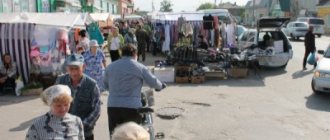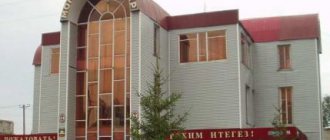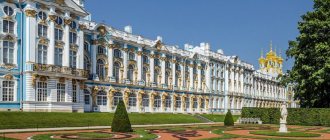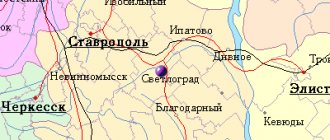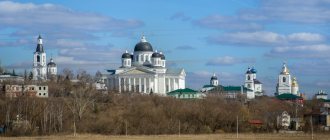Exploration and start of industrial production[edit]
At the turn of the XIX - XX centuries. The first steps were taken to organize mining enterprises in the Minusinsk region. But its development was hampered by the uninhabited territory, the lack of developed communications, and difficult climatic conditions.
The coal-bearing strata of the Chernogorsk deposit was divided into 5 formations from bottom to top: Sokhkelskaya, Sarskaya, Chernogorskaya, Poberezhnaya and Beloyarskaya. The data were assigned to the Carboniferous-Carboniferous period. The upper half of the Chernogorskaya suite contained the main industrial layers of the field: Gigant III, Gigant II, Gigant I, Mezhstratovy, Moshchny, Bezymyanny II, Bezymyanny I, Unsustainable, Velikan II, Velikan I, Dvukharshinny, Inconsistent2. The total thickness of the formation reached 270–300 meters.
The field was located on the northwestern edge of the South Minusinsk depression, on the left bank of the Yenisei River, 10 km northwest of the mouth of the Abakan River. The total area reached 250 square meters. km. The thickness of the coal-bearing residues in the center was 630 m, the depth of the main working seams did not exceed 300 m. (Total coal reserves as of January 1, 2012 amounted to 1545 million tons.)
The discovery and start of industrial development of the deposit is associated with the name of Vera Arsenyevna Balandina, a graduate of the Bestuzhev Higher Women's Courses in St. Petersburg, a chemist, and a Master of Science. In 1905-1906 she was invited to Minusinsk by the director of the Martyanovsky Museum A. A. Yarilov to set up a chemical laboratory in the museum. On her instructions, in 1906, Stepan Kuzmich Okulov, who soon became the manager of the Chernogorsk mine, conducted research and identified 5 coal seams with a maximum working thickness of up to 5 meters.
In 1907, exploration continued and industrial coal mining began. It was in the hands of the private Montenegrin Coal Company organized by the Balandin spouses. The consumers of the company's coal were the Siberian Railway, the state-owned shipping company, the river police, distillation plants, a brick-making factory, contractors for the construction of the Siberian Railway, the Yenisei Shipping Company, the Krasnoyarsk brewery, salt factories, the Minusinsk brewery and others.
In 1912, the geological committee began systematic research in the Minusinsk region, as a result of which new deposits were identified and the contours of the coal basin, called Minusinsk, began to emerge. In 1915, D.V. Sokolov compiled the first schematic five-verst geological map of the Yenisei-Abakan depression, including the Chernogorskoye, Izykhskoye and Kalyaginskoye fields, which were combined into one Minusinsk basin.
Article “80 years of the Montenegrin mines station”
The life of Chernogorsk, or rather the working
village of Kopi, located in the bare steppe 9 km from the Yenisei River, where only shepherds and herdsmen had previously visited, was given by coal found here in 1907.
For a long time, the Khakass people had a legend
that in these places on Mount Kara Tigei (black hill) lives the hero Kara Tag (black mountain).
Residents of the nearest uluses, apparently, had already known about the unusual hot stone, but did not attach much importance to it. From a Khakass shepherd who grazed a flock of sheep here, Stepan Kuzmich Okulov, a mining operator at the Izykh mines, heard about the amazing black hill and became interested in this place.
With the help of Khakass Oka Boinov, he found here layers of surface coal, which, under the influence of melting and burning, turned from black to red. Okulov told about his discovery to the district mining engineer Volkonsky and his assistant Yakovlev. They advised him to make applications for the discovery and apply for funds for research and development to the Moscow millionaire Brunts.
But money was found closer, in Minusinsk, from local entrepreneurs the Balandins, who became the first owners of the deposit.
And Okulov was offered the position of manager of the mines. There was no one and nowhere to sell the coal. The calculation was made for local industry and population. For many years, fertile, rich in natural resources, concealing in their depths almost the entire periodic table, the lands of Khakassia and the south of the right bank of the Yenisei were connected with the rest of Russia by the river, serving as the main transport route. The idea of building the Achinsk-Minusinsk railway was born to the owner of the Montenegrin coal mines, Vera Arsenyevna Balandina, who took up its practical implementation. A native of the Novoselovsky district, the daughter of a local merchant, Vera Emelyanova graduated from the Bestuzhev Higher Courses and studied in Geneva, at the Sorbonne. Knowledge of the potential of the native land resulted in a desire to help realize it. Having married the son of the richest Yenisei merchant, professor at St. Petersburg University Alexei Balandina, Vera Arsenyevna returned to Siberia and energetically got down to business. Having bought a coal deposit, she built a narrow-gauge railway from the Chernogorsk mines to a pier on the banks of the Yenisei, and along it they transported coal to steamships. That narrow-gauge railway can be considered the first railway in Khakassia. And the “Montenegrin Mines” can be considered the beginning of the big railway to this region, from here, from Balandina.
A. Pozdeev.
“Montenegro mines. 1925"
The Montenegrin Mines station was a dead end and looked nondescript. It was not lit; they used kerosene hand-held lanterns.
4 colors: red, blue, yellow, white.
A two-axle turntable with wooden channels went to Abakan.
At the station there was a dormitory, there was a common cellar where railway workers stored vegetables and potatoes, there was a horse on which grandfather Tamonin carried the station manager Mikhailenko around the facilities. There were already a lot of objects then. Weighers walked through the mines to accept coal; there was a weighing station on track 5. When talking about the Montenegrin Mines station, it is impossible not to talk about those people who stood at the origins of its foundation.
One of them is Kelemenev Ignatiy Nikolaevich.
He got a job at the station in 1936 . During the Great Patriotic War he was called to the front, where he participated in the restoration of railway lines. Having been demobilized, he returned to his hometown and worked as a lineman until 1962. His daughter, Elena Ignatievna Petryakova, worked for 23 years as a switch post attendant. Following in the footsteps of their grandfather and mother, Galina Petrovna Markanova and Vera Aleksandrovna Nastyushkina work at the station. Family work experience 109 years. Since the beginning of the Great Patriotic War, the volume of transportation has increased significantly. to the front. A rifle division was formed in Abakan, and there was a pilot school in Chernogorsk. Trains with wounded arrived from the front and were treated in Abakan hospitals. At that time, railway workers worked according to wartime conditions. Many men went to the front, and women and teenagers took their place. In 1942 they came to work at the Montenegrin Mines station: Anna Grigorievna Dotsko, worked as a situation worker in a technical office for 39 years.
Matveeva Maria Grigorievna, worked for 21 years as a duty officer at a 4 km crossing.
Mozhnova Anna Ivanovna, worked as a commodity cashier for 37 years. In 1943, they began their working career: Anastasia Mikhailovna Shaforost, worked as a merchandise cashier. Litvishko Valentina Tarasovna, worked as a switchman for 34 years.
In 1970,
they wrote about her in the local newspaper Shakhtar. “Not only does she keep her station in exemplary condition, but she is also a community train safety officer.”
Having been demobilized from the ranks of the Soviet Army in 1950,
Matvey Ivanovich Litvishko came to work on the railway. He worked as a coupler, compiler, and station attendant for 34 years. Veteran of labor, is on a well-deserved rest.
Life flows on peaceful tracks.
Railway workers work at their jobs. They also take part in communist subbotniks, go to agricultural work, and take part in demonstrations. In 1964, a kindergarten was opened, headed by Nina Ivanovna Esaulova. The station is famous for its dynasties. Tarasov dynasty.
Total work experience 197 years. The head of the Tarasov dynasty is Vasily Evdokimovich.
In 1946 he came to work at the station. Tarasov Ivan Vasilievich - son, work experience 40 years.
Shkitskaya Lyudmila Vasilievna - daughter, works as a senior acceptance clerk.
Tarasova Galina Vasilievna - daughter-in-law, worked for 31 years as a dispatcher. Koryakin Victor - son-in-law, worked as a machinist for 38 years. Grandchildren: Nadezhda Ivanovna Koryakina, senior commodity cashier for 23 years, Vlada Vladimirovna Tarasova has worked as a delivery and acceptance clerk for 14 years, Vyacheslav Viktorovich Koryakin has worked as a diesel locomotive driver for 24 years. Shkitskaya Evgenia Valerievna, receiver and delivery person, has been working since 1994.
Tarasov Vladislav Vladimirovich, has been working as a conductor since 2000.
Markanov dynasty.
Total work experience 150 years. The head of the Markanov dynasty is Vasily Ivanovich. A year before the start of the Great Patriotic War, he was drafted into the active army, fought, and reached Berlin. In 1946, he got a job as a compiler at the Montenegrin Mines station.
Work experience 46 years. Markanova Pelageya Tikhonovna - wife, 5 years of experience.
Markanov Vladimir Vasilievich - son, diesel locomotive driver, 36 years of experience.
Markanova Galina Pavlovna - daughter-in-law, commodity cashier, 37 years of experience.
Markanov Alexander Vladimirovich - grandson, diesel locomotive driver with 24 years of experience.
Markanov Vladimir Vladimirovich - grandson, assistant locomotive driver, 2
years of experience.
In 1926, the Montenegrin mines station was put into operation.
The first locomotive has arrived. Only in 1968 did diesel locomotives arrive at the station, and in 1975 - electric locomotives.
From 1929 to 1958, Nikolai Dmitrievich
Mikhailenko worked as the head of the station, from 1958 to 1978. — Georgy Ivanovich Doroganov. The veteran of labor is on a well-deserved rest. Currently he works as Deputy Chairman of the Council of Veterans of the Abakan Branch of the Railway.
Then the station was led by: Valentin Ivanovich Rogozha; Vasily Fedorovich
Shevchenko. Currently, deputy head of the Abakan branch for
HR and social work; Alexander Vladimirovich Pakhanov, Alexander
Vladimirovich Anisimov.
Among those who made the greatest contribution to the activities of the station are the weighers: Alexandra
Artemyevna Pavlova, Maria Nikolaevna Zagorulko, Nadezhda Stepanovna Marenko, train compiler Ivan Konstantinovich Petrukhin, head of the goods office Maria Yakovlevna Bakulmanova, switchman Sara Zalmovna Smirina, senior weigher Alexander Ivanovich Gerasimenko, coupler Ilya Danilovich Sergeev; switchmen: Maria Petrovna Fedorenko, Anna Grigorievna Kharitonova, dispatcher Nadezhda Grigorievna Bogodukhova.
IN
There are currently two parks at the station.
In park “A” there are two tracks for accumulating
cars and forming trains, a running track, a sorting track, a loading and unloading track, a track for uncoupling repairs and a track for cutting up cars. In park "B" there is a main, dispatch, 4 receiving departure tracks, a track for cleaning and sorting cars, an exhaust track, a loading and unloading track, a connecting track, and a safety track. The station is adjacent to the access roads of enterprises.
In 1990, a new station building was built.
In 1996,
electrical centralization was introduced at the station, and a contact network was installed at the ends of the tracks.
There are technical and sales offices equipped with computers, and a technical training room.
Along with the new station building, a new village for the families of railway workers was also built.
Currently, the Montenegrin mines station is operating stably.
The shipped coal is exported to Latvia, Estonia, Lithuania, Bulgaria, Poland, Turkey, Hungary, Belarus, Moldova 2221 wagons per month, and in Russia 5000 wagons, which is 469 thousand tons of coal.
In recent years, the work of the Veterans Council has intensified.
Having made an outstanding contribution to the work of the station, the veterans are still active. Since 2002, when the Veterans Council was formed, it was headed by Nadezhda Grigorievna Bogodukhova and Nadezhda Stepanovna Marenko.
ABOUT
They didn’t know that they were working not in simple production, but on the railway.
Here, not only an hour, but sometimes a minute of delay is unacceptable and is fraught with the most serious consequences. And they always remembered this. And they started their careers 30-40 years ago.
Today everyone is taking a well-deserved rest. There are 120 people in the Veterans Council. Of these, 7 are men. Most have worked for more than 30 years. If the enterprise has the opportunity to help veterans, this means
the Council has more opportunities. Caring for veterans is a priority in the work of the station management and the trade union. Veterans are provided with financial assistance and benefits: free rail travel, health vouchers to the Magistral sanatorium, discounts on the cost of coal and its free removal, and Blue Lights events are held.
Coal mining enterprises[edit]
In the pre-revolutionary period, coal mining was carried out in three mines No. 1 “Ermak”, No. 2, No. 3 in the Dvukharshinny and Velikan seams. In the early 1920s. they were closed or mothballed. At mine No. 1 “Ermak”, work ended on March 13, 1924 due to a fire from the overhead headframe, which then spread to the mined-out space of the Velikan seam. Mine No. 2, founded on the Velikan seam, was closed in September 1923, as its reserves had been exhausted.
Mine No. 3 was operated with great interruptions, and for a long time was considered a reserve mine. It was built on the Moshchny formation. Since 1925, production was carried out at the newly opened mines No. 5 “Khakasskaya” and No. 6 “Oktyabrskaya” in the northeastern part of the field, which developed the Velikan formation. Mine No. 5 was 45 meters deep and was in operation until 1928, and No. 6 went 25 meters higher along the seam uprising, which, in fact, was a mistake by the surveyors, so it was already closed in 1927. All the coal in these two mines above the groundwater level was exhausted, and further mining was impossible because there were no drainage facilities.
The excavation of mine No. 7, which began in 1927, involved only exploration purposes and temporary coal production until it was connected to mine No. 8; a year later, mine No. 7 was mothballed. In 1933, construction began on a new inclined mine No. 7-bis, the first stage of which was commissioned in 1934 when the Dvukharshinny and Velikan seams were opened. The second stage was commissioned in 1939, when the Moshchny and Gigant seams were opened by a vertical shaft, the mines were connected under the name mine No. 7.
Mine No. 8 had been in operation since 1927, and in 1928 they began to deepen and expand it.
Mine No. 9 with a huge volume of coal production was planned even before the 1917 revolution. It was founded in 1932, capital investments amounted to more than 1 million rubles, however, work was suspended. In 1933, they were frozen due to the high depth of occurrence (about 90 meters), the complex mining mechanism, and the absence of a coking component in Montenegrin coal. It re-entered the operating mines in 1960.
Legends and there were cities near the Black Mountain
By the standards of many cities, Chernogorsk is still very young, only 85 years old! Yes, even if you take from the founding of the village of Chernogorskie Kopi, the forerunner of Chernogorsk, you won’t look old either, because the village was founded a little more than a century ago, in 1907.
But even during a relatively short life by the standards of history, the chronicles of Chernogorsk contain a lot of interesting, joyful and sad, heroic and glorious pages.
Probably all Montenegrins remember from school lessons that life in our city was given by geological research, which resulted in the idea of building a miners’ settlement near the Black Mountain, and the active entrepreneurial activity of Vera Arsenyevna Balandina, the owner of coal mines.
In the first years of the 20th century, Stepan Okulov, a young mining operator from Izykh Kopi, who was only 23-24 years old at that time, heard from local residents a legend about the Black Hill, where stones burn. As a master of mining, he naturally became interested and went to explore this amazing place.
The archives record that Stepan Kuzmich then carried out exploration of several layers and made 16 applications in his name for their development, but there was no money to expand mining operations, the foreman’s salary was only 35 rubles. In a word, Stepan Okulov had to look for an investor who would agree to take a risk and invest considerable funds in construction. Vera Balandina turned out to be such a wealthy investor.
In 1902, they together examined the outcrops of the Dvukharshinny and Velikan seams, admired the high quality of the coal, and entered into an agreement with each other, according to which Vera Balandina financed the project, and Stepan Okulov accepted the position of mine manager with a salary of 100 rubles. And in 1908, the first 3,490 pounds of coal were produced.
Since then, the life of a mining village began, which was later transformed into a city. On January 20, 1936, the village was given a new name - the city of Chernogorsk.
LEAVING THE PAGES OF “SOVIET KHAKASSIA”
Of course, living witnesses of those years can no longer be found, but newspaper articles and archival records remain, which today are available to everyone who is interested in the history of the city. But I must say that reading old newspapers is, although very difficult (alas, microfilms of printed pages of those years are extremely difficult to read), but very exciting.
Unfortunately, the pre-war archive of the Montenegrin newspaper “Udar”, founded five years before the city appeared, has been preserved only in the Russian State Library in Moscow; these pages have not yet been transferred to digital format. But the pre-war issues of the newspaper “Sovetskaya Khakassia” have been digitized - yes, that’s exactly how the name of our autonomous region was written for a long time, with two “s”. Only in March 1954 was a new spelling of the region finally established - Khakassia. So, in that pre-war “Soviet Khakassia”, which began publishing in 1931, a lot of materials were devoted to Chernogorsk.
It is worth noting that in the early 30s, Chernogorsk was increasingly criticized. And first of all, they condemned the lagging work of coal mining enterprises. Whatever the title, it’s a call to punish, to call to order, to shame. However, other villages in Khakassia suffered no less. Criticism was then extremely developed. The newspaper constantly demanded that district and city authorities finally start working normally. Stop sabotage and sloppiness.
And I must say, they were not particularly shy in their expressions.
For example, in the issue of “Soviet Khakassia” dated August 1, 1931, on the front page, the material “Equip the coal miners of Montenegro with modern technology” was published with the subtitle: “To blow up the scab of a brainless, Oblomov-like and irresponsible attitude to the task of mastering production technology - such is the duty of the party and professional organization of Chernogorsk "
However, after a few years the intensity of the revelations decreased. Now the newspaper not only called for accountability and demanded that work be improved, but also, so to speak, educated people through positive examples. Headlines in the style of “We look up to them”, “Let’s support initiatives”, “Stakhanovite Isaev” and so on began to appear more and more often.
On February 1, 1936, in the publication “About Stakhanov’s days in Chernogorka” they wrote: “The regional committee notes that the first Stakhanov days in Chernogorka were held on December 26-28 and in early January, when daily coal production rose to 2600 tons against 1800 tons during 1935 ., turned out to be an excellent school and showed that Montenegro has every opportunity to work much better, more organized, and more productive. The Stakhanov day revealed large reserves and showed that even more reserves remained undetected.”
At that time, housewives became increasingly involved in social work. They were still reluctant to go into production, but they were already beginning to show zeal in everyday affairs. An interesting note appeared in February 1936, as they would say now - volunteers are in action and are not afraid of obstacles.
“Nothing will work out for you, that’s what they said in the city education department when they were informed that, on the initiative of the regional committee of the All-Union Communist Party of Bolsheviks, the parents’ meeting of the auxiliary school decided to organize a Christmas tree for the children.
The skeptics from the city's office were wrong. It turns out that even without standard toys you can give children great pleasure, cultural, joyful leisure. Funds for purchasing material and decorating the Christmas tree were raised through local trade union committees of the city. The toys were prepared by the parents themselves and some of the Komsomol members of the printing organization.
Beads and tinsel were replaced by leaded chocolate paper, ribbons and ruby stars. Pioneer students made airplanes, skiers, etc. Parents prepared costumes for dancing snowflakes and dragonflies.
Finally everything is ready. On February 6th, in the red corner of the printing house, from 4 o'clock, first grades and preschoolers are held. There was no end to the children's joy when multi-colored light bulbs flashed. Each of the 200 children present wanted to see all the toys.”
Day after day, week after week, the events of those years remained in the memory thanks to the work of dozens of journalists who wrote about the work of miners and villagers, talked about problems in the school and improvement of the city, criticized the leadership and demanded to improve the culture of work and leisure. In short, reading the newspapers of those years, you can get a pretty good idea of the life of people in the first third of the 20th century.
THE PREDICTION CAME TRUE
By the way, around those years, and perhaps a little earlier, a significant story, as it later turned out, took place in the Montenegrin mines.
clerk of the Church of the Nativity of the Blessed Virgin Mary, Anastasia Rudenko, told us about this
— A special milestone in the life of the city is the Church of the Nativity of the Virgin Mary, where at first I was just a parishioner, and then I began to work. Next year the temple will be thirty years old! It has already become part of the city.
Such an incident is recorded in the annals of the temple.
Once upon a time, when there was no Chernogorsk yet, but only the village of Chernogorsk , a deeply religious man named Nikita Antonovich lived here. He settled in a dugout next to the place where, decades later, the Church of the Nativity of the Blessed Virgin Mary was built. The elder was a literate man, he prayed, read the Gospel and the Psalter, and one day he predicted that a temple would be built in the place where he lived.
Over the years, of course, this prediction was forgotten. And when in the late 80s it was decided to build a church in Chernogorsk, the first rector of the temple, Father Seraphim (Bryskin) and the head of Chernogorsk, Vladimir Sorokin, searched for a suitable place for a long time. In the end, we settled on a site on Lenin Street, where our temple now stands.
The choice was not accidental. After all, the temple should be in a place accessible to citizens. Moreover, people come here to pray for the dead. And the fact that there is a monument to the dead miners next to us is very significant. Subsequently, a chapel of the Royal Passion-Bearers was built here and a memorial was erected in memory of those repressed. And when children or adult pilgrims come to us on excursions, and we conduct them often, we make sure to tell not only about the temple, but also about the history of the city, about the dead miners, their work.
When the church decided to compile a chronicle, they, of course, turned to the Montenegrin archive. It was there that a long-standing prediction about a shrine on the site of the elder’s dugout was discovered. The memory of Nikita Antonovich was recorded from the words of one of the first parishioners of the temple, Agrippina Georgievna Bykova. There is such a touch in the history of Chernogorsk.
Today you often hear not very kind words addressed to the city. But I love him. My whole life is connected with him. I was actually born in Krasnoyarsk, but a month later my mother brought me back to Chernogorsk, and I’ve been here ever since. I can’t imagine my life without our city.
By nature, I am a rather conservative person; if I have settled in one place, I don’t want to move. It’s another thing to go somewhere on vacation, see other cities and regions, but then be sure to return home.
It hurts me that only lazy people don’t criticize the place where they live, but is it really that bad here?
In my opinion, a city is about people, and I have met many wonderful people in my life. Who helped and supported when it was difficult. When I was studying at the university, the then mayor of the city, Oleg Pustoshilov, paid me a personal scholarship. She graduated from the institute, and Vladimir Sorokin, who by that time had become the head of Chernogorsk, helped her get a job. I remember the teachers at the ninth school where I studied, and their friendly attitude. In general, I was very lucky to meet good people.
I have a long-standing friendship with your newspaper. I started writing notes for Montenegrin Worker when I was still in school.
So many wonderful people have lived and still live in Chernogorsk! There is a special attitude towards miners here, because in many families people worked in the mines. This is also a special feeling for me. Both of my grandfathers worked at the Yeniseiskaya mine, giving their strength, health, and best years for the good of the city. this is very valuable and important.
MY CITY -
MY HISTORY
It is impossible not to recall the names of wonderful local historians who devoted their lives to studying the history of our city. This, of course, is Valentina Vasilievna Antonova - the first director of the history museum, its founder and first researcher.
By the way, a year ago, Valentina Vasilyevna, in an interview with a journalist from “ChR”, made a proposal - to immortalize in the memory of the city not only the names of war heroes, but also home front workers, the people who created and built Chernogorsk. And in a recent interview with the Minister of Culture of Khakassia, Svetlana Okolnikova spoke about the idea of competing to award the city the title “City of Labor Glory.”
Who among lovers of the history of Chernogorsk does not know the names of Georgy Gavrilovich Morozov and Valery Alekseevich Chubrikov! These ascetic local historians opened many forgotten pages in the history of our city. They have collaborated with our newspaper for dozens of years, and when leafing through old files, you can often come across materials written by them.
How many residents have they instilled an interest in the city’s past and awakened a love for it! These people who wrote the history of Chernogorsk became history themselves.
HAPPY BIRTHDAY, MONTENEGORSK!
Natalya Pobyzakova, gymnasium mathematics teacher:
— I was not born and raised in Chernogorsk, but I have been living here for more than 30 years, and during this time it has become my real home. Recently, my children suggested that my husband and I change our apartment and move to Abakan, but with all the advantages of Abakan, I don’t want to live there. I really like Chernogorsk, it is small and cozy.
And look how much is being done for people in the city. I am amazed at the courage of those who are trying to improve our city - there is no money, and we understand this. However, there are still many positive changes. Near the gymnasium where I work, a park appeared - paths, benches.
I love our park very much, my grandchildren and I go there every other day and spend several hours - it’s beautiful, varied, and interesting for the children. I'm not a car driver, so I don't pay much attention to the roads. Except that we would like to see sidewalks built; unfortunately, we have a problem with them.
In general, the city is friendly, there are many good people. There are problems, but where do they not exist?
Alexey Bashtakov, acting head of the Chernogorsk traffic police:
— Chernogorsk is a city of strong people! It has great potential, and Chernogorsk is expecting a breakthrough in all areas ahead of its development. This is the city where I live and work. I like it because it is cozy and small.
Kirill, TSU student:
— I was born and lived in the Far East until I was ten years old, but then my father was transferred to Chernogorsk for work. Now I study and live in Tomsk. In general, my parents and I traveled a lot around the country, and, of course, Chernogorsk is not the most developed and comfortable city. There are no nightclubs here, there are few places for young people to go. There is no comparison with Tomsk or Novosibirsk.
But I like Chernogorsk. The fact that it is small, that there is no traffic like in big cities, that you don’t have to travel for hours to get to school or work. While it’s difficult to think about the future, where I will live and work, I don’t know, judging by the mood I’m in now, I would return to Chernogorsk, to my favorite yard for Cosmonauts.
Prepared by Valentina KORZUNOVA
Photos by the author and from the groups “Chernogorsk - the city of my childhood”, “Typical Chernogorsk”, as well as from other open sources.
"ChR" No. 66 dated August 32, 2022
Subordination[edit]
On February 18, 1920, by a resolution of the Ural-Siberian Commission of the Supreme Economic Council and the Council of Workers' and Peasants' Defense of the RSFSR, the Board of Coal Mines of Western Siberia "Sibugol" was formed. All coal mines and enterprises of Omsk, Novo-Nikolayevsk, Altai, Tomsk, Yenisei provinces and Semipalatinsk region were under his jurisdiction. At the same time, all coal enterprises in Western Siberia were nationalized and came under the control of the Soviet government. "Sibugol" was divided into territorial production groups - rayugli. The Board of Coal Mines was in charge of all issues related to the operation of coal mines, the construction of structures related to the development of coal and the production of geological exploration surveys.
Sibugol was directly subordinate to the Ural-Siberian Commission and Glavugol of the Supreme Economic Council. In April 1920, the Ural-Siberian Commission was transformed into the Siberian Council of National Economy, and the Board became part of it with the rights of the main board and was renamed the Board of Coal Mines of the Central Region of Siberia. In October 1920, the Siberian Coal Committee “Sibkomugol” was organized and the Board became a member of it as a district administration. The mines of Kuzbass were divided into groups corresponding to 5 districts: Anzhero-Sudzhensky. Northern Kuznetsk, Central Kuznetsk, Southern Kuznetsk and Minusinsk. The Office of the Minusinsk Coal Region was created.
In August 1922, Sibugol was divided into two independent organizations: the State Association of the Kuznetsk Basin Coal Industry - Kuzbasstrest and Cherembass.
In 1924, after the formation of the Khakasssky district, the mines of the Minusinsk region, united in the salt and coal industry trust "Khakugol", were subordinated to the Krasnoyarsk Gubernia Economic Council, then transferred to the disposal of the Krasnoyarsk Gubernia Executive Committee, and then the Khakass Regional Executive Committee. In 1925-1926 The mines of the Chernogorsk mines worked in the Khaksolugol association; in 1927, on the basis of a resolution of the Council of Labor and Defense of July 2, 1927, the enterprises became part of the newly formed State Coal, Chemical and Metallurgical Trust "Kuzbassugol", the management of which was located in Novosibirsk. Since 1926, coal mining in Khakassia has focused exclusively on the Montenegrin mines. The main consumers of coal from the Montenegrin mines in the early 1930s were railways and water transport.
Over the following years, the name and structure of organizations managing the Kuzbass coal industry changed repeatedly. In 1932, a new management body for the coal industry of the basin appeared in Novosibirsk - the Kuzbassugol trust, which united the management of the Kuznetsk and Minusinsk basins. In 1933, the Khakass Mining Administration was organized. In 1936, on the basis of the Kuzbassugol trust and its mining departments, the independent Khakasugol trust was organized.
